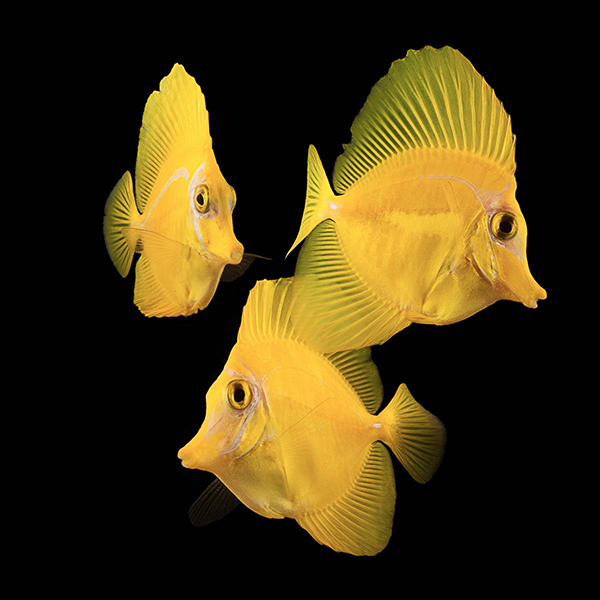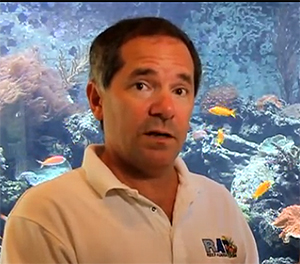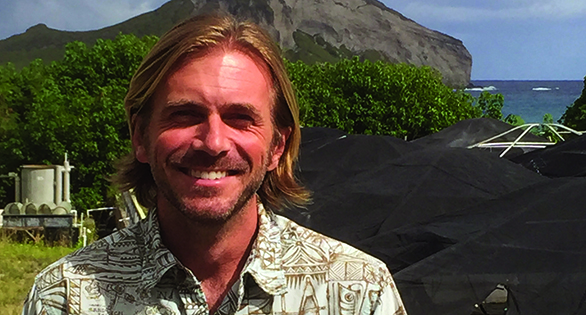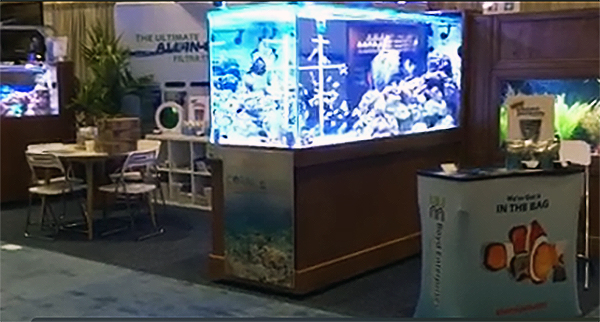
Several of more than 300 captive-bred Yellow Tangs to arrive at Segrest Farms and Quality Marine, March 7th, 2016. Image courtesy Sandy Moore/Segrest Farms.
The result of decades of aquaculture experimentation and more research dollars than have been expended on any other marine aquarium fish species, members of the first successful captive spawning and rearing of Yellow Tangs to achieve market size will appear in the week of March 14th at Global Pet Expo 2016. The fish were bred and raised at the Oceanic Institute of Hawaii Pacific University, under the leadership of Chatham “Chad” Callan, Ph.D., director of finfish breeding programs.
Related Story: The Tangs Have Landed

Jeff Turner of Boyd Enterprises, a longtime supporter of marine aquaculture for the aquarium trade. Image: Jon Carlin.
“We are thrilled to have these first aquacultured Yellow Tangs to display,” says Jeffrey A. Turner of Boyd Enterprises.”Its really awesome that OI and the Rising Tide organization have brought us to this milestone achievement in Marine Ornamental Aquaculture.
Dr. Chad Callan, director of the program that accomplished this breeding milestone at the Oceanic Institute, will be hosted by Boyd and available to meet with members of the aquarium trade during the three days of Global Expo, March 16-18. An annual Orlando event, Global Expo is expecting a record turnout in the range of 16,000 people from the pet industry. This trade show is not open to the general public.
“It’s with great enthusiasm and respect that we are able to fly Chad in for Global and it will be fantastic to have industry representatives and key store owners be able to speak with Dr. Callan face-to-face and to see his team’s fish in our displays at the show.”
Limited Supply of First Tangs
The two initial shipments of more than 300 juvenile Yellow Tangs each, from mature broodstock originally collected in Hawaiian waters, arrived at Quality Marine in Los Angeles and Segrest Farms in Gibsonton, Florida on Monday, March 7th. Insiders say that chances of any of these fish turning up in a local aquarium shop are virtually nil, as most have already been ordered by public aquariums and zoos. Members and supporters of the Rising Tide Conservation Initiative, including Sea World Orlando, are reportedly eager to exhibit the success of one of their key projects.
The captive breeding and rearing of a species of marine aquarium fish with pelagic spawning habits is regarded by many as a major breakthrough that has been years in the making. The vast majority of marine aquarium fishes are pelagic spawners, producing tiny eggs and planktonic larvae that demand expert care and feeding. Countless production bottlenecks husbandry unknowns have defeated breeding efforts by many would-be breeders. To ensure a steady supply of a popular species such as the Yellow Tang, many in the marine trade would like to have access to both wild-caught and aquacultured fish. The news of success from Callan’s lab in late 2015 has reverberated around the ornamental marine industry.
HLLE or “Epithelial Thinning”?
As the initial shipments of fish settled in, a posting by Jake Adams of the Reef Builders blog suggested that the fish were suffering from Head and Lateral Line Erosion (HLLE), a disfiguring condition especially common in surgeonfishes. “Unfortunately, it seems that nearly all of the captive bred yellow tangs suffer from fairly advanced head and lateral line erosion (HLLE),” Adams wrote on March 10. “Alas, it looks like the first captive bred yellow tangs also have a long way to go before they could be really considered ‘market ready’.
However, others looking at the same images of the tangs came to a different diagnosis. “I do not think that it is “classic” HLLE,” says Jay Hemdal, curator of fishes at a leading American zoo aquarium, and an expert on HLLE. “YTs with HLLE develop fin erosion and you see just pale yellow regions around the eye, not white.” Hemdal has published research demonstrating a very strong correlation between exposure to carbon dust and the onset of HLLE in marine fishes. (1)
“I think it is a result of two things: the flash photography washing out the thin skin around the face, as well as a syndrome known as ‘epithelial thinning’,” says Hemdal. “This may just be a result of the fish having recently metamorphosed from the larval stage. We know now that the fish weren’t exposed to carbon, so classic HLLE can be ruled out.”
Eli Fleishauer of Quality Marine believes the problem, whether HLLE or something else, will be resolved. “We released the images and wanted to be transparent with everyone that these first fish have signs of what looks like HLLE. People getting these tangs will know that they may have to work to get them to recover.”
Meet Chad Callan
Live displays of the OI-bred Yellow Tangs will be found at the big Global show in Boyd’s traveling 150-gallon reef aquarium, while a 500-gallon display will house other Rising Tide captive-bred fishes and cultured Acropora cervicornis and A. palmata colonies grown by Coral Reef Restoration. Chad Callan says he will be delighted to meet at the booth talk about the trials and tribulations of getting these first Zebrasoma flavescens to market.

Dr. Chatham “Chad” Callan of Hawaii’s Oceanic Institute will attend Global Pet Expo in Orlando. His work with the Rising Tide Initiative has helped bring the first aquacultured Yellow Tangs to market this year.
“I’d be pleased to meet with anyone and talk about the fish, our research and what we hope to do in the coming months. I’m particularly interested in talking with industry people who might be willing to partner with/support us for furthering these methods,” Callan told CORAL Magazine. ” I’d like people to know that we still have A LOT of research to do before this is commercially feasible. I think it’s important to stress that if people would like to see cultured Yellow Tang again that we need continued support. We don’t want this to be a one off.”
Callan says that it is important for the marine hobbyists and trade to know that the US companies bringing in the first fish are donating all profits back to the research program in Hawaii. “I think it’s an important message that Segrest and QM are in fact trying to help the “cause” here, and are not just trying to capitalize on this moment. They have been somewhat “vilified” in some comments about “HLLE” this week, and I would like your readers to know that they are likely not making anything on these fish, but rather have been good enough to take on the efforts of distribution to primarily public aquariums…. Likely at “cost” or even at a loss.
“The HLLE issue is something we will need to address in the future,” says Callan, “but it would be great to help correct the assumption that these wholesalers are in this only for the money, when in fact they are actually trying to further this effort by supporting us.”
A Global Debut

The 500-gallon reef exhibit Boyd Enterprises will present at the Global Show to display aquacultured fishes and corals, some from Rising Tide successes.
Boyd’s Jeff Turner, a longtime supporter of marine captive breeding, invites all Global Pet Expo attendees to stop by and see the historic tangs from themselves. (Turner expects that Sandy Moore and a team from Segrest may also have some aquacultured Yellow Tangs on display near the Aquatic Lounge.)
“All is set for the Yellow Tang display in the Chemipure Booth #1448 at Global Pet Expo that starts next Wednesday March 16th and runs through the 18th at the Orange County Convention Center in beautiful and warm Orlando, Florida,” says Turner.
2016 Global Pet Expo Show Dates and Hours
Global Pet Expo
March 16-18, 2016
Orange County Convention Center
Orlando, Florida
Show Hours:
Wednesday, March 16: 9am – 6pm
Thursday, March 17: 9am – 6pm
Friday, March 18: 9am – 5pm
Move-in Days/Times for Exhibitors
Monday, March 14: 8am-6pm
Tuesday, March 15: 8am-6pm
References
[1] Hemdal, J. & R. Andrew Odum. 2011. The Role of Activated Lignite Carbon in the Development of Head and Lateral Line Erosion in the Ocean Surgeon. North American Journal of Aquaculture, Volume 73, Issue 4, 2011. pages 489-492
DOI: 10.1080/15222055.2011.635781
http://www.tandfonline.com/doi/abs/10.1080/15222055.2011.635781
Adams, Jake. Would you pay a hundred dollars for a scarred yellow tang? Reef Builders. 3/10/2016. Accessed 3/11/2016.
https://reefbuilders.com/2016/03/10/would-you-pay-a-hundred-dollars-for-this-yellow-tang/



